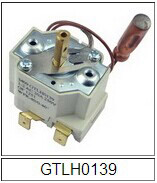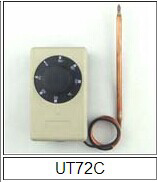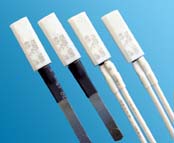Temperature Control Switch Working Principle
Classification of common temperature control switches: vapor pressure type, electronic type, metal expansion type
According to the temperature change of the working environment, a physical deformation occurs inside the switch, thereby generating some special action effects, and a series of automatic control components that are turned on or off, called a temperature control switch. Also called temperature protector or temperature controller, referred to as temperature controller. Or through the temperature protector to pass the temperature to the temperature controller, the temperature controller issues a switch command to control the operation of the device to achieve the desired temperature and energy saving effect.
Vapor pressure type
The action of the bellows acts on the spring, and the spring force of the spring is controlled by the knob on the control panel. The capillary tube is placed at the air intake port of the air conditioner indoor, and reacts to the temperature of the indoor circulating return air. When the room temperature rises to the set temperature, the temperature sensor gas in the capillary and bellows expands, making the bellows elongate and overcoming the spring's elasticity to connect the switch contacts. At this time, the compressor is running, the system is cooled, and when the room temperature drops to the set temperature, the temperature-inducing gas shrinks, the bellows shrinks together with the spring, and the switch is placed in the off position to cut off the motor circuit of the compressor. This is repeated to achieve the purpose of controlling the temperature of the room.

Electronic temperature controller
The electronic temperature controller (resistive type) is measured by the method of temperature sensing of the resistor. In general, platinum wire, copper wire, tungsten wire and semiconductor (thermistor, etc.) are used as temperature measuring resistors. These resistors have their own advantages and disadvantages. The sensor of household air conditioning is mostly thermistor type.
The thermistor thermostat is based on the Wheatstone bridge principle. Connect the power supply E to both ends of the BD. According to Kirchhoff's law, when the resistance of the bridge R1 × R4 = R2 × R3, the potentials of the two points A and C are equal. No current flows between the outputs A and C. The magnitude of the resistance R1 of the thermistor changes as the ambient temperature rises or falls, causing the balance to be broken and an output current between the ACs. Therefore, when the thermostat is constructed, the temperature adjustment range and the operating temperature can be easily changed by selecting an appropriate thermistor.

Metal expansion
According to the principle of thermal expansion and contraction of objects. Thermal expansion and contraction are commonalities of objects, but different objects have different degrees of thermal expansion and contraction. The two sides of the double gold piece are conductors of different substances. At varying temperatures, the double gold piece is bent due to the different degree of shrinkage, and the set contact or switch is touched to start the set circuit (protection).

According to the temperature change of the working environment, a physical deformation occurs inside the switch, thereby generating some special action effects, and a series of automatic control components that are turned on or off, called a temperature control switch. Also called temperature protector or temperature controller, referred to as temperature controller. Or through the temperature protector to pass the temperature to the temperature controller, the temperature controller issues a switch command to control the operation of the device to achieve the desired temperature and energy saving effect.
Vapor pressure type
The action of the bellows acts on the spring, and the spring force of the spring is controlled by the knob on the control panel. The capillary tube is placed at the air intake port of the air conditioner indoor, and reacts to the temperature of the indoor circulating return air. When the room temperature rises to the set temperature, the temperature sensor gas in the capillary and bellows expands, making the bellows elongate and overcoming the spring's elasticity to connect the switch contacts. At this time, the compressor is running, the system is cooled, and when the room temperature drops to the set temperature, the temperature-inducing gas shrinks, the bellows shrinks together with the spring, and the switch is placed in the off position to cut off the motor circuit of the compressor. This is repeated to achieve the purpose of controlling the temperature of the room.

Electronic temperature controller
The electronic temperature controller (resistive type) is measured by the method of temperature sensing of the resistor. In general, platinum wire, copper wire, tungsten wire and semiconductor (thermistor, etc.) are used as temperature measuring resistors. These resistors have their own advantages and disadvantages. The sensor of household air conditioning is mostly thermistor type.
The thermistor thermostat is based on the Wheatstone bridge principle. Connect the power supply E to both ends of the BD. According to Kirchhoff's law, when the resistance of the bridge R1 × R4 = R2 × R3, the potentials of the two points A and C are equal. No current flows between the outputs A and C. The magnitude of the resistance R1 of the thermistor changes as the ambient temperature rises or falls, causing the balance to be broken and an output current between the ACs. Therefore, when the thermostat is constructed, the temperature adjustment range and the operating temperature can be easily changed by selecting an appropriate thermistor.

Metal expansion
According to the principle of thermal expansion and contraction of objects. Thermal expansion and contraction are commonalities of objects, but different objects have different degrees of thermal expansion and contraction. The two sides of the double gold piece are conductors of different substances. At varying temperatures, the double gold piece is bent due to the different degree of shrinkage, and the set contact or switch is touched to start the set circuit (protection).






